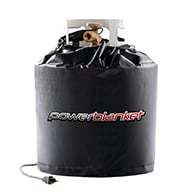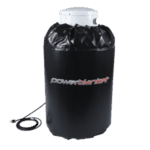Propane Use Indoors | Safety and Application Considerations
Indoor heating is essential during cold weather, especially for regions with freezing temperatures. A variety of heating systems can be used to achieve the desired level of warmth and comfort indoors, including gas cylinder and propane tank heaters. While these heating systems are widely used, they come with potential risks and hazards. In this article, we will discuss how to use propane indoors safely, highlight the dangers and benefits of using propane stoves and propane heaters, and provide tips on how to reduce the risks associated with their use.
When it comes to outdoor heating or providing supplementary heat to a space, there are different types of heating systems to choose from. Two popular options are heaters that use propane or gas cylinders to run a heating unit and heating jackets or wraps that control the temperature and flow of the propane itself.
Heaters that use propane or gas cylinders are versatile and portable, making them an excellent choice for outdoor heating, camping, or providing supplementary heat to a space. They work by burning propane or butane gas from a cylinder or tank, generating heat almost instantly. These heaters come in different sizes, from small portable units to larger, more powerful heaters that can heat larger spaces. While these heaters are efficient, easy to use, and provide heat almost instantly, it is essential to prioritize safety indoors or outdoors.
Heating jackets or wraps are a different type of heating system that is designed to regulate the temperature and flow of propane itself. They are commonly used in industrial settings where propane is used as a fuel source, such as in construction or manufacturing. The heating jackets or wraps are placed around propane tanks or cylinders, preventing the propane from freezing in cold temperatures and regulating the flow of propane to the heating system. These jackets are typically made of durable materials and can withstand harsh environments, making them a reliable option for industrial settings.
Our heated propane tank jackets feature industrial-grade insulation and full-wrap heating elements to ensure proper flow without the risk of overheating. With custom solutions or ready-to-ship products to fit standard propane tank sizes, we can help you maintain a steady propane flow all winter long.
In this article, we will explore the differences between heaters that use propane or gas cylinders to run a heating unit and heating jackets or wraps that control the temperature and flow of the propane itself. We will discuss the benefits and drawbacks of each type of heating system and provide tips for safe and efficient use. Whether you are looking for a heating solution for outdoor activities or industrial settings, understanding the differences between these two heating systems can help you make an informed decision.
Safe Indoor Propane Use
Propane is a highly flammable gas and can be extremely dangerous if used incorrectly. When propane burns, it produces carbon monoxide (CO) gas, which is highly toxic and can cause carbon monoxide poisoning. CO is a colorless and odorless gas that can cause death if inhaled in high concentrations. Therefore, when you plan to use propane indoors, it is essential to take safety precautions seriously.
Propane Stoves and Propane Heaters
Propane stoves are commonly used for cooking in outdoor spaces but can also be used indoors. A propane stove should never be used indoors unless designed for indoor use. Portable propane stoves are not recommended for indoor use because they do not have proper ventilation, and their size makes them difficult to handle. Additionally, using propane stoves indoors increases the risk of carbon monoxide poisoning.
On the other hand, propane heaters are designed for indoor use and come with safety features like oxygen depletion sensors. These sensors detect the oxygen level in the air and turn off the propane heater if the oxygen level is too low. However, propane heaters can still be dangerous if misused. Incomplete propane combustion can lead to CO and exhaust fumes, both of which are hazardous to human health.
Carbon Monoxide and Propane
Carbon monoxide is a byproduct of burning propane. When propane burns correctly, it produces carbon dioxide and water vapor. However, if there is an insufficient supply of oxygen or if the propane is not burned completely, it can produce carbon monoxide. Carbon monoxide can also be produced if there is a leak in the propane system.
Propane gas is heavier than air and can accumulate in low-lying areas, making it difficult to detect a leak. A propane gas detector can detect leaks and alert homeowners before it becomes hazardous. Installing a carbon monoxide detector is also important for monitoring the level of carbon monoxide in the air. Homeowners should install both propane gas and carbon monoxide detectors in their homes to ensure safety.
Using a Propane Stove Indoors
Propane stoves are designed for outdoor use, and using them indoors can be dangerous. If you need to use a propane stove indoors, it is essential to follow safety precautions. Here are some tips for using a propane stove indoors safely:
- Use a propane stove that is specifically designed for indoor use.
- Use the propane stove in a well-ventilated area.
- Open windows and doors to allow fresh air to circulate.
- Keep the propane stove away from flammable materials like curtains, furniture, and clothing.
- Never leave a propane stove unattended.
- Turn off the propane stove when you are done using it.
- Never use a propane stove for heating a room.
- Install a carbon monoxide detector in your home.
Storing Propane Tanks Indoors
Propane tanks should never be stored indoors, even in unheated spaces. Storing propane tanks indoors can increase the risk of propane leaks, leading to an explosion or fire. Propane tanks should be stored outside in a well-ventilated area, away from direct sunlight and sources of heat.
Proper Ventilation and Fresh Air Circulation
Proper ventilation and a source of fresh air are critical when using propane indoors. Adequate ventilation helps to reduce the risk of carbon monoxide buildup in the air. When using a propane heater or stove, it is important to open windows and doors to allow fresh air to circulate. If possible, using a fan to circulate the air can also be helpful.
Safety Precautions When Burning Propane Indoors When using a propane heater indoors, it is essential to follow the manufacturer’s instructions carefully. Here are some tips to reduce the risk of accidents:
- Install a carbon monoxide detector and check it regularly.
- Have the propane heater inspected and maintained annually by a professional.
- Only use propane heaters that have been certified for indoor use.
- Keep flammable materials like curtains and furniture away from the propane heater.
- Do not place anything on top of the propane heater.
- Do not use the propane heater to dry clothes.
- Turn off the propane heater before leaving the room or going to sleep.
- Never use the propane heater in an unventilated area.
- Do not use propane heaters in the bathroom, as they can cause excessive moisture buildup and lead to mold growth.
- Keep up with required maintenance.
Using Natural Gas Instead of Propane
Natural gas is a safer alternative to propane for indoor use. Natural gas is piped directly into the home, eliminating the need for propane tanks. Natural gas is also cleaner-burning than propane and produces fewer emissions. Natural gas heaters are typically more energy-efficient than propane heaters, and natural gas is less expensive than propane.
Choosing the Right Propane or Gas Cylinder Heating Jacket
Choosing the right propane or gas cylinder heating jacket can be challenging, given the different types and styles available on the market. Here are some factors to consider when choosing the right propane or gas cylinder heating jacket for your needs:
- Size and compatibility: Propane and gas cylinder heating jackets come in different sizes and are designed to fit specific propane tanks or cylinders. It is essential to choose a heating jacket that is compatible with the size and type of propane tank or cylinder you will be using.
- Temperature range: Different heating jackets have different temperature ranges, depending on their intended use. Some are designed to keep propane from freezing in cold temperatures, while others are designed to regulate the flow of propane to the heating system. Consider the temperature range you will need for your specific use case.
- Material and durability: Propane and gas cylinder heating jackets are typically made of durable materials that can withstand harsh environments. Consider the quality of the material and the durability of the heating jacket when making your decision.
- Insulation: A good propane or gas cylinder heating jacket should have proper insulation to prevent heat loss and maximize efficiency. Consider the level of insulation when choosing a heating jacket.
- Power source: Some heating jackets require an external power source, such as electricity or batteries, to function. Consider the availability of a power source when choosing a heating jacket for your needs.
- Ease of installation: Propane and gas cylinder heating jackets should be easy to install and remove, allowing for quick and easy access to the propane tank or cylinder. Consider the ease of installation when choosing a heating jacket.
- Safety features: Look for propane and gas cylinder heating jackets that come with safety features, such as automatic shut-off or overheat protection, to prevent accidents and hazards.
By considering these factors, you can choose the right propane or gas cylinder heating jacket for your specific needs, ensuring your heating system’s safe and efficient use.
Key Considerations
In conclusion, propane and gas cylinder heaters are useful heating systems for outdoor and indoor use, but their use comes with potential risks and hazards. It is essential to prioritize safety when using these heaters indoors or outdoors. Always follow the manufacturer’s instructions and take necessary precautions to ensure safe and efficient use. It is also important to consider the differences between heaters that use propane or gas cylinders to run a heating unit and heating jackets or wraps that control the temperature and flow of the propane itself.
When it comes to using propane indoors, it is crucial to follow safety precautions, such as proper ventilation and fresh air circulation. Carbon monoxide and propane are dangerous when misused, and homeowners should install both propane gas and carbon monoxide detectors in their homes to ensure safety. Furthermore, choosing the right propane or gas cylinder heating jacket is essential to ensure compatibility with your propane tank or cylinder and to consider factors such as temperature range, material and durability, insulation, power source, ease of installation, and safety features.
By taking safety precautions seriously and choosing the right heating system, you can enjoy warmth and comfort in your indoor or outdoor space without compromising on safety. Remember to always prioritize safety when using propane or gas cylinder heaters indoors or outdoors.
Keep your propane tanks at the perfect pressure with Powerblanket.








